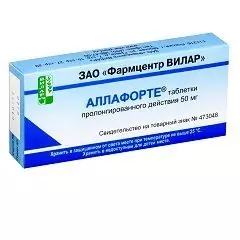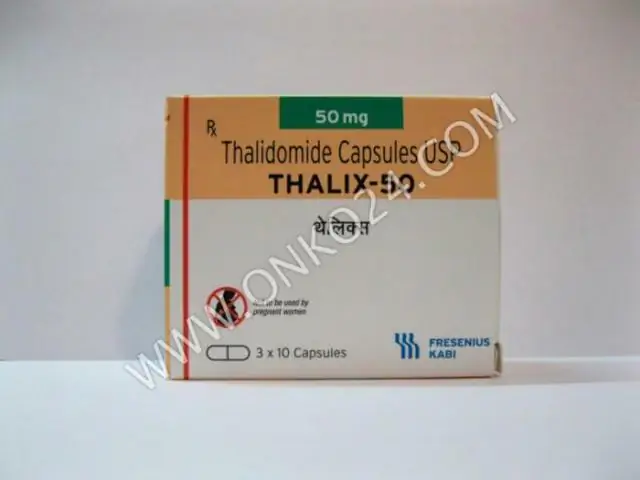- Author Rachel Wainwright [email protected].
- Public 2023-12-15 07:39.
- Last modified 2025-11-02 20:14.
Allaforte
Allaforte: instructions for use and reviews
- 1. Release form and composition
- 2. Pharmacological properties
- 3. Indications for use
- 4. Contraindications
- 5. Method of application and dosage
- 6. Side effects
- 7. Overdose
- 8. Special instructions
- 9. Application during pregnancy and lactation
- 10. Use in childhood
- 11. In case of impaired renal function
- 12. For violations of liver function
- 13. Drug interactions
- 14. Analogs
- 15. Terms and conditions of storage
- 16. Terms of dispensing from pharmacies
- 17. Reviews
- 18. Price in pharmacies
Latin name: Allaforte
ATX code: C01BG
Active ingredient: lappaconitine hydrobromide (Lappaconitine hydrobromide)
Manufacturer: JSC Pharmcenter VILAR (Russia)
Description and photo update: 2019-10-07
Prices in pharmacies: from 479 rubles.
Buy

Allaforte is an antiarrhythmic agent.
Release form and composition
Dosage form - prolonged-release tablets: round, biconvex, from white to white with a yellowish or grayish shade of color (10 and 15 pcs. In blister contour packs, in a cardboard box for consumer packaging 1-3 packs and instructions for use of Allaforte) …
Composition of 1 tablet:
- active substance: lappaconitine hydrobromide - 25 or 50 mg (in terms of 100% substance);
- auxiliary components: hypromellose, lactose monohydrate, calcium stearate, pregelatinized starch, colloidal silicon dioxide (Aerosil A-380).
Pharmacological properties
Pharmacodynamics
The active substance of Allaforte is lappaconitine hydrobromide - the hydrobromic salt of the alkaloid lappaconitine with accompanying alkaloids. It is extracted from the grass or roots and rhizomes of the white-toothed wrestler (Aconitum leucostomum Worosch), from the roots and rhizomes of the northern wrestler (high) (Aconitum septentrionale Koelle) or from the technical sum of alkaloids of the buttercup family.
Allaforte is a class IC antiarrhythmic drug. Blocks fast sodium channels of cardiomyocyte membranes. Slows down atrioventricular (AV) and intraventricular conduction, suppresses impulse conduction along additional pathways in Wolff-Parkinson-White syndrome. It shortens the functional and effective refractory periods of the atria, Purkinje fibers, AV node and bundle of His.
Lappaconitine hydrobromide has a moderate antispasmodic, coronary dilating, sedative and local anesthetic effect.
The effect develops within 40-60 minutes after taking Allaforte, it remains at the achieved level for 4-5 hours, after which it begins to gradually decrease. In general, the effect of lappaconitine hydrobromide is maintained for at least 12 hours.
Allaforte has no effect on blood pressure (BP), heart rate (HR), myocardial contractility (provided that there are no symptoms of heart failure), conduction along the AV node in the anterograde direction and the duration of the QT interval. The automatism of the sinus node does not oppress. It has no antihypertensive and m-anticholinergic effect. It has no negative inotropic effect.
Pharmacokinetics
After oral administration from the gastrointestinal tract, lappaconitine hydrobromide is absorbed slowly. The maximum plasma concentration (C max) is reached on average within 80 minutes, after which it remains practically stable for 4-5 hours, and gradually decreases over the next 24 hours.
In chronic heart failure II - III functional class according to NYHA classification, absorption of the drug is slowed down, C max is noted after 2 hours.
Bioavailability is 56%, which is due to the effect of the first pass through the liver. The main metabolite with pharmacological activity is deacetylappaconitine.
The volume of distribution of the drug is 690 liters. Lappaconitine hydrobromide crosses the blood-brain barrier (BBB). With prolonged use in the body does not accumulate.
The half-life (T 1/2) is approximately 7.2 hours, but increases 2-3 times in patients with chronic renal failure, 3-10 times in patients with liver cirrhosis.
No more than 28% of the dose is excreted unchanged by the kidneys, the remaining amount is excreted through the intestines.
Indications for use
- ventricular and supraventricular premature beats;
- paroxysmal ventricular tachycardia (in the absence of organic changes in the myocardium);
- paroxysmal supraventricular tachycardia, including with Wolff-Parkinson-White syndrome;
- paroxysmal form of atrial fibrillation and atrial flutter.
Contraindications
Absolute:
- chronic heart failure III - IV functional class according to NYHA classification;
- heart defects;
- acute coronary syndrome;
- cardiogenic shock;
- sinoatrial blockade;
- restrictive cardiomyopathy;
- dilated cardiomyopathy;
- arrhythmogenic cardiomyopathy (dysplasia) of the right ventricle;
- blockade of the right branch of the bundle of His, combined with a blockade of one of the branches of the left leg;
- long or short QT interval syndrome;
- severe hypertrophy of the left ventricular myocardium (≥ 1.4 cm);
- severe arterial hypotension (systolic blood pressure less than 90 mm Hg);
- myocarditis;
- Brugada syndrome;
- postinfarction cardiosclerosis;
- AV blockade of the I degree with an extension of the PQ interval of more than 200 ms;
- AV block II and III degree in patients without an artificial pacemaker (IVP);
- lactase deficiency, lactose intolerance, glucose-galactose malabsorption;
- severe kidney and / or liver dysfunction;
- alcohol abuse;
- age up to 18 years;
- period of breastfeeding;
- no antiarrhythmic effect during treatment with allapinin in history;
- a history of arrhythmogenic action of any antiarrhythmic drug;
- hypersensitivity to any component of Allaforte.
Relative (Allaforte tablets should be used with extreme caution):
- bradycardia;
- blockade of one of the legs of the bundle of His;
- sick sinus syndrome;
- violation of intraventricular conduction;
- cardiac ischemia;
- violations of water and electrolyte balance (hyperkalemia, hypokalemia, hypomagnesemia);
- severe disorders of peripheral circulation;
- benign prostatic hypertrophy;
- angle-closure glaucoma;
- simultaneous use of other antiarrhythmic drugs;
- pregnancy.
Allaforte, instructions for use: method and dosage
Allaforte should be taken orally with meals. The tablets should be swallowed whole (without breaking, crushing or chewing) and washed down with a sufficient amount of drinking water at room temperature.
The doctor selects the optimal therapeutic dose individually. At the beginning of treatment, Allaforte is prescribed 25 mg - 1 tablet 3 times a day (at intervals of 8 hours). If the severity of the effect is not enough, you can increase the dose to 25 mg 4 times a day (at intervals of 6 hours) or up to 50 mg 2 times a day (at intervals of 12 hours). When evaluating the effectiveness of the initial and each subsequent (increased) dose, it should be borne in mind that a stable effect develops within 2-3 days.
The maximum permissible daily dose is 100 mg (50 mg 2 times a day or 25 mg 4 times a day). The use of Allaforte in higher doses is not recommended because adequate controlled studies have not been conducted.
In order to avoid undesirable effects of the drug on the cardiac conduction system, treatment should be started and doses should be increased under the control of an electrocardiogram (ECG). It is advisable to register the ECG values 1-2 hours after taking the next dose.
In case of PQ lengthening to 300 ms or development of atrioventricular blockade of a higher degree than was available, the Allaforte dose should be reduced or the drug should be temporarily discontinued.
It is safe to lengthen the QRS complex by up to 25% of the initial value, however, provided that the QRS duration does not exceed 140 ms. The QRS complex must not be lengthened by more than 50% of the original or more than 160 ms.
The need to correct the dosage regimen and the duration of treatment is determined by the doctor.
Side effects
- on the part of the heart: very often (≥ 10%) - disturbances of intraventricular and AV conduction, changes on the ECG (expansion of the QRS complex, lengthening of the PQ interval); often (from ≥ 1% to <10%) - increased blood pressure, sinus tachycardia (with prolonged use); infrequently (from ≥ 0.1% to <1%) - arrhythmogenic effect;
- from the nervous system: very often - a feeling of heaviness in the head, headache, ataxia, dizziness;
- on the part of the organ of vision: very often - diplopia (double vision);
- from the skin and subcutaneous tissues: often - hyperemia of the skin, allergic reactions.
Overdose
Allaforte is characterized by a small range of therapeutic efficacy, therefore it can quickly cause severe intoxication, especially when used together with other antiarrhythmic drugs.
Possible overdose symptoms: blurred vision, dizziness, headache, marked decrease in blood pressure, decreased myocardial contractility, expansion of the QRS complex, asystole, bradycardia, increased amplitude of the T wave, paroxysms of polymorphic ventricular tachycardia, atrioventricular and sinoatrial block and lengthening of the QT interval, PQ - intestinal disorders.
Gastric lavage is recommended as a first aid measure. Overdose treatment is symptomatic. If necessary, dobutamine and diazepam are administered, heart defibrillation, artificial lung ventilation, and indirect heart massage are performed.
In case of development of ventricular tachycardia, it is contraindicated to use class IA and IC antiarrhythmics.
special instructions
Allaforte is available in the form of prolonged-release tablets, which ensures slower absorption and even distribution of lappaconitine hydrobromide in the blood at intervals between doses. This reduces the frequency of development and the severity of side effects.
When transferring a patient to Allaforte from other antiarrhythmic drugs, in case of their ineffectiveness, it is allowed to start treatment in terms of more than 2-5 half-lives of these drugs (depending on their doses). Otherwise, mutual strengthening of the negative influence on the function of the cardiac conduction system is possible. If the patient is transferred from amiodarone, it is allowed to start taking Allaforte immediately after its cancellation, since it has a very long half-life, however, additional precautions are required, which are recommended in combination therapy.
Before starting treatment with the drug, it is necessary to eliminate the existing violations of the water-electrolyte balance, and during the use of Allaforte - to control the level of electrolytes in the blood.
Each patient should undergo an ECG and a clinical examination before taking Allaforte and systematically during the course of therapy in order to identify possible side effects in time, evaluate the effectiveness of treatment and the feasibility of its continuation.
If diplopia, dizziness or headache appears while taking the drug, the Allaforte dose should be reduced. If, with long-term treatment, sinus tachycardia develops, the appointment of beta-blockers is required.
In patients with established IVR, the threshold for its stimulation may increase. Pacemakers should be tested and reprogrammed if necessary.
Allaforte can cause serious adverse reactions in patients with significant organic changes in the myocardium. Patients with stable angina pectoris and ischemic heart disease require particularly careful observation during treatment and exercise stress testing, since high heart rate and transient myocardial ischemia are predisposing factors for the development of arrhythmogenic effects of class IC antiarrhythmic drugs.
In patients with severe organic changes in the myocardium, when using class IC antiarrhythmic drugs, there is an increase in the incidence of serious side effects. Allaforte can be prescribed to such patients only in exceptional cases, by decision of the council of doctors.
Influence on the ability to drive vehicles and complex mechanisms
Patients who are employed in potentially hazardous industries that require speed of reactions or increased attention, and vehicle drivers during the period of use of Allaforte should be careful.
Application during pregnancy and lactation
In animal studies, lappaconitine hydrobromide, used in doses of 1-5 mg / kg, did not show the presence of teratogenic and embryotoxic effects. However, no controlled studies have been conducted in pregnant women, so the use of Allaforte is not recommended. The drug can only be prescribed in exceptional cases when the expected benefit is definitely higher than the possible risks.
There is no data on the penetration of the drug into breast milk, therefore, Allaforte should not be prescribed to nursing mothers, or it should be recommended to refuse breastfeeding.
Pediatric use
The antiarrhythmic agent is not used to treat pediatric patients (under the age of 18).
With impaired renal function
Allaforte is contraindicated in severe functional disorders of the kidneys.
For violations of liver function
Allaforte is contraindicated in severe liver dysfunction.
Drug interactions
With the simultaneous use of other antiarrhythmic agents, the likelihood of the development of adverse reactions due to the effect on atrioventricular conduction and sinus node function increases. If it is necessary to prescribe such a combination, the dose of each drug should be carefully selected.
Lappaconitine hydrobromide enhances the effect of non-depolarizing muscle relaxants. Does not affect the properties and safety of indirect anticoagulants.
Changes in the pharmacokinetics of Allaforte with the simultaneous use of inducers of microsomal liver enzymes were not observed.
In clinical studies, no increase or decrease in the hypotensive effect was noted when lappaconitine hydrobromide was added to standard antihypertensive therapy with the following drugs: beta-blockers, slow calcium channel blockers (dihydropyridine derivatives), ACE inhibitors (angiotensin-converting enzyme), ARA II receptor antagonists (ARA II receptor antagonists) (ARA II) (antagonists).
Analogs
Allapinin, Amiodarone, Cardiodarone-Health, Cordaron, Lidocaine, Multac, Novocainamide, Propanorm, Refralon, Ritmonorm, Etatsizin, etc.
Terms and conditions of storage
Store in a dark place at a temperature not exceeding 25 ° C. Keep out of the reach of children.
The shelf life is 3 years.
Terms of dispensing from pharmacies
Dispensed by prescription.
Reviews about Allafort
Most of the reviews about Allafort are positive: the drug effectively restores the normal heart rhythm. However, there are many reports of the development of side effects, due to which patients were forced to interrupt taking the pills. The following reactions are mentioned: pressing pain in the head, severe dizziness, loss of orientation in space, itching, a significant increase in blood pressure, diplopia.
The cost of Allaforte is generally estimated to be high.
Price for Allafort in pharmacies
The price for Allaforte depends on the dosage, the number of tablets in the package, the region of sale and the pharmacy chain that sells the drug.
The approximate cost of Allaforte 25 mg prolonged-release tablets is 529-675 rubles. per pack of 20 pcs., 50 mg - 549-640 rubles. per pack of 10 pcs.
Allaforte: prices in online pharmacies
|
Drug name Price Pharmacy |
|
Allaforte 50 mg prolonged release tablets 10 pcs. RUB 479 Buy |
|
Allaforte 25 mg extended release tablets 20 pcs. 492 r Buy |
|
Allaforte prolonged action tablets 25mg 20 pcs. RUB 499 Buy |

Maria Kulkes Medical journalist About the author
Education: First Moscow State Medical University named after I. M. Sechenov, specialty "General Medicine".
Information about the drug is generalized, provided for informational purposes only and does not replace the official instructions. Self-medication is hazardous to health!






